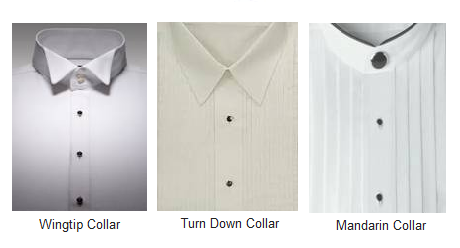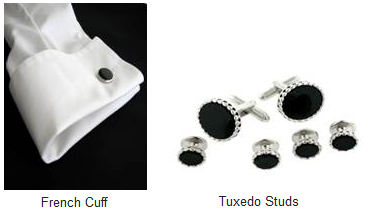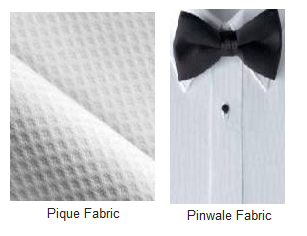 Many consider the tuxedo shirt to be the main attraction of a tuxedo ensemble; the featured piece that pulls it all together and reveals the tuxedo’s magnificence and purpose. Whether you share that perspective or not, the tuxedo shirt deserves and requires as much contemplation as the tux itself – not only for esthetic value, but because the shirt, above all else, should reflect the type of event it’s worn to. With that in mind, let’s talk about tuxedo shirts, so you’ll always be in the right shirt at the right time.
Many consider the tuxedo shirt to be the main attraction of a tuxedo ensemble; the featured piece that pulls it all together and reveals the tuxedo’s magnificence and purpose. Whether you share that perspective or not, the tuxedo shirt deserves and requires as much contemplation as the tux itself – not only for esthetic value, but because the shirt, above all else, should reflect the type of event it’s worn to. With that in mind, let’s talk about tuxedo shirts, so you’ll always be in the right shirt at the right time.
Today’s tuxedo shirt comes in a variety of styles, from very formal to more casual, and offers options that generations before us did not have. Although it’s great to have these choices that allow and encourage individual expression, these numerous options can make choosing the appropriate shirt more complex than ever. Variety, coupled with today’s relaxed tuxedo etiquette, can blur shirt-selecting rules, especially for those of us who infrequently wear a tux. But don’t despair… fashion faux pas can be avoided every time by following the simple, yet all-important rule that guarantees a harmonious ensemble: match the shirt to the tuxedo style. Doing so will assure fashion appropriateness, regardless of the event or your personal expression.
Tuxedo shirts vary in many ways, with the most notable difference being the collar style. Other features: fabric, fronts, bibs, cuffs, and buttons are options that makeup the various styles and lend to our personal flair. Understanding how and when to wear the various features takes the guesswork out of selecting a shirt, and ensures a picture perfect package… so let’s break it down.
Collar Styles
Choose the collar style first when selecting a shirt. Another factor to consider when choosing a shirt is the type tie, if any, that will be worn, so decide on that before making a shirt selection.
Wingtip: This is, without question, the most elegant of collar/shirt styles. This classic tuxedo collar has centuries of tradition behind it, and boasts formal all day long. It is versatile enough to accommodate both bow ties and neckties, and can be worn with either a vest or cummerbund. The collar stands straight up with its front edges bent over, giving the appearance of small wings – hence the name wingtip. Wear this style collar to all formal affairs, especially those designated “very formal”.
Turn Down Collar: Also known as the Laydown Collar, this collar resembles the typical collar design found on button-down dress shirts. Considered both traditional and contemporary, it’s not as formal as the wingtip collar, but is still acceptable for formal affairs, including very formal ones (although etiquette prefers the wingtip). It can accommodate both bow ties and neckties.
Mandarin: This is a band collar that stands straight up and fastens in the front with one button. This style does not use a tie of any kind, but is often adorned with a decorative button cover instead. Considered an alternative tuxedo shirt style, this collar is typically worn by younger men who prefer to defy tradition and make their own fashion statement. Of the three collar styles, the Mandarin is the most casual. Regardless of age and who wears it, it should never be worn to a very formal event.
Shirt Fronts
Pleated: The front of the shirt has vertical pleats in the bib area. Pleats vary in size and range from 1/8th of an inch to 1 inch wide. Typically, rental and service shirt pleats are 1/4 inch wide, while the classic tuxedo shirt sports a 1/2 inch pleat. Higher-end retail shirts normally have pleats 1/2 inch or wider. This is simply a design style and does not necessarily reflect the shirt’s status; however, pleats do add a more formal flair. Pleated shirts can be found with every collar style, and can be dressed up with a bow tie, or dressed down with a necktie. The size of the pleat chosen should be based on personal preference.
Non-Pleated or Flat: This shirtfront has no pleats, but instead has a flat bib that’s made from a pique material (see below). A non-pleated shirt is considered very formal, and, according to etiquette, should only be worn with tuxedo tails; however, many nonconformists wear it with any tux.
Cuffs
French Cuffs: This is the preferred choice of cuff for tuxedo shirts, especially formal ones. The length is twice as long as a standard shirt cuff, so that the fabric can be folded back onto itself and secured with a cufflink. It’s classy and an elegant choice for black-tie events.
Convertible Cuffs: This cuff is designed like most dress shirt cuffs, and does not have the additional fabric and length of the French Cuff. These cuffs are convertible because they come with both a button and optional cufflink slit. When opting to wear cufflinks with any tux shirt, make sure they’re formal.
Fabrics
100% Cotton: Traditionally, cotton has been and still is the fabric of choice for tuxedo shirts. Its versatility and comfort make cotton an excellent choice for all styles. Expect a hefty price tag, especially with high-end brands.
- Pique Cotton: This is a high quality cotton that’s commonly used on non-pleated shirt fronts – literally, just the shirtfronts. Due to its high cost, only the finest shirts are made of 100% pique, while the majority of non-pleated shirts are constructed of pique in the front, and have a less expensive cotton or cotton/poly blend throughout the rest of the shirt. Although the quality is superior, it’s the fabric’s weave or texture that makes it ideal for adding elegance to a plain shirtfront. When examined closely, the honeycomb and diamond like patterns can be seen. Another term for this material is Marcella.
- Pinwale: This is actually a type weave and not a specific fabric. Pinwale fabric is created from tightly twisted fibers that produce ribs or cords, similar to those found on pinwale corduroy. The ridges on tuxedo shirts are so tight and fine, they’re barely noticeable, yet still produce an elegant shirt that’s gaining popularity. Typically, only the shirtfront is made of pinwale, but shirts completely designed in pinwale are also available. The fabric is normally cotton, but cotton blends exist, also.
Poly/Cotton Blends: Most rental shirts are made of poly/blends because the fabric is sturdier, more wrinkle and stain resistant, and cheaper than 100% cotton to manufacture. Blended shirts are normally found in the pleated style.
Microfiber: It’s the latest synthetic fabric that boasts the softness of cotton, and the wrinkle resistance of polyester, in addition to being very colorfast. Brightly colored tuxedo shirts are often made of this fabric because it holds and retains color so well. This fabric offers the best of all worlds, and should be considered when rich color and style are on the menu.
Buttons
Every tuxedo shirt comes with the manufacturer’s standard buttons, and all but the Flyfront shirt offers the option of wearing studs. Studs are an accessory that cover the existing buttons and match the cuff links. Studs, like cufflinks, come in countless metals, colors, and material and definitely add something extra to the entire outfit. I’m frequently asked about their purpose and whether it’s recommended to wear them or not. True, they do spice things up, but does not wearing them detract from the tuxedo’s appearance, or render the tuxedo less formal? Etiquette says no – they are an option only, whose usage is based on personal preference. So, the bottom line is, while they do make a tuxedo dressier, they do not make it more (or less) formal.
Not every shirt has its buttons exposed. Neckties, ascots, and any low hanging neck-wear drapes over the buttons, keeping them out of sight, so there’s no need for studs. Flyfront tuxedo shirts conceal the buttons with an additional flap of shirt fabric that covers them in the same way fabric covers a zipper, so, again, studs are out. The use of studs when wearing a vest is questionable, since most of the buttons are covered up – although it’s totally acceptable to wear them together. Studs are most commonly worn and maximized when wearing a bowtie and cummerbund because the entire shirtfront is visible. Still, studs are a matter of personal preference and expression, so the choice is yours.
Gentlemen, that pretty much covers the basics of tuxedo shirts; however, there is one more thing worth mentioning. For those of you needing a slim cut shirt, you’ll be happy to know the tuxedo industry is on-board! Hopefully, this article will make your search for the perfect tux shirt an easy one. If not, no problem… that’s what the tuxedo professionals are here for!
by Aaron Marino
Modern Tailor Also Has Tuxedo Shirts

















